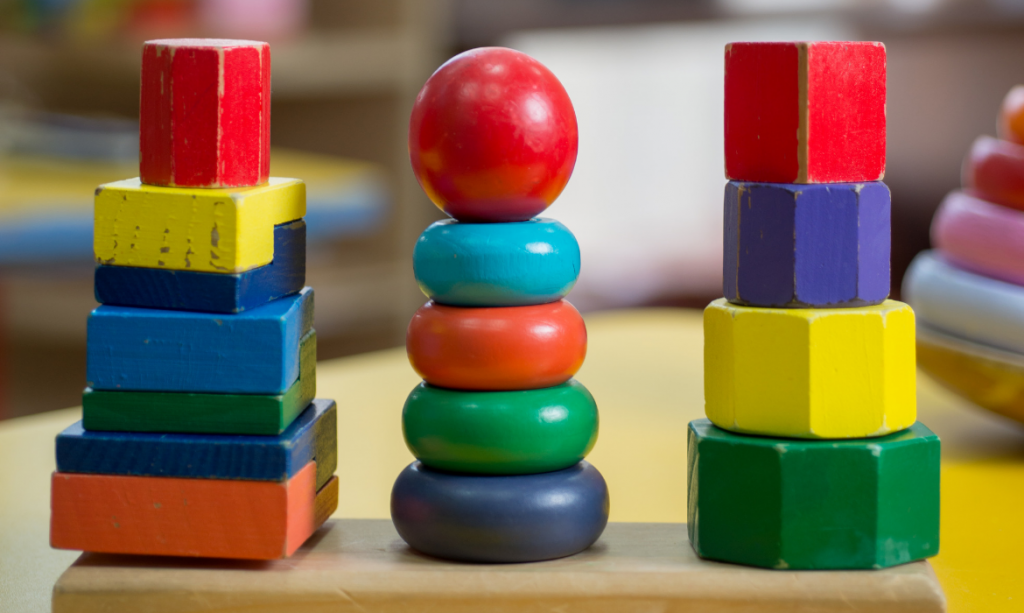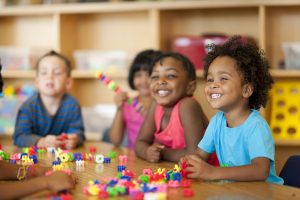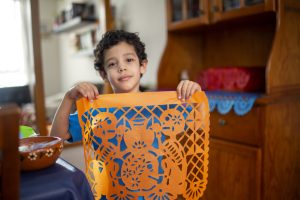Jasmine, DeShawn, and Andrea are playing with blocks and build two towers: a red tower made of three small blocks and a blue tower made of three big blocks. Jasmine says the blue tower is bigger because it’s taller, but Andrea points out that they’re both made with three blocks. DeShawn reaches for a ruler so that they can check which is bigger and know for sure. Even though DeShawn is the only one with a ruler, all the kids are measuring—just in different ways.
Young children compare and measure things all the time, and in natural and spontaneous ways. These early understandings of measurement are foundational for children’s later math learning in school. Here are some ways parents can use every day talk and playful activities to support children’s developing understanding of measurement.
What is Measurement?
Anytime we use a process to find out the size, length, or amount of something, we’re measuring. That can mean we put an object on a scale to determine its weight in pounds or use a ruler to measure an object’s length in inches. But it can also mean counting to get the total number of items in a set, or using pennies to decide a stick is 10 pennies long. Kids start comparing things very young, and they don’t need to know about formal units, like pounds and inches, to do it.
Why is Measurement Important?
People need to measure things throughout their lives, including weight, time, length, and many other measureable dimensions. It’s likely not surprising, then, that measurement is a critical aspect of school mathematics across elementary and middle school. [1] Children’s early ideas about measurement, such as comparing sizes, form the basis for other important aspects of mathematical thinking and learning. [2]
Why is Measurement Hard?
Learning how to measure with units can be hard for young children. [3, 4] Kids need to know a lot about units and how to use them, like lining up pennies so there aren’t any gaps, or understanding that the units need to be the same size (using only pennies or only quarters rather than mixing them) to get a consistent measurement. In some cases children might create units when units aren’t obvious, like using hand lengths to measure a friend’s height.
Using a ruler can help by giving children standard units, but learning how to use a ruler can be difficult, too. For example, imagine you lined up a crayon at the 3-inch mark on a ruler, and it reached the 5-inch mark. When asked how long the crayon is, kids might say it’s 5 inches long, though it’s actually 2 inches long. Even though kids know how to compare sizes, lengths, and amounts, they might not know how these comparisons relate to formal measuring using units.

What Do Counting and Measurement Have in Common?
Units are important even before kids start measuring, because we use units when we count. When we count something, the thing that we’re counting is the unit. We can count trucks, fire trucks, blue trucks, truck wheels, or even all the vehicles, and the unit, the thing we are counting, changes. But this isn’t always clear to children.
In fact, children have a really hard time counting parts of objects, like the number of truck wheels, because they are so focused on the whole object, the number of trucks. [4]Helping children make connections between units and comparisons (based on size, length, amount, etc.) can help them correctly use measurement procedures when they need to. [5, 6] Explicitly labeling the unit when counting is one way to support these connections.
Supporting Your Child’s Early Measurement Skills
You can support your young child’s early measurement skills by helping make connections between approximation, comparison, counting, and measurement. Here are some tips.
Approximation and Comparison
- All children are naturally curious about their environment and are constantly comparing things, even before they have the words to describe what they are comparing. You can help your child by using comparison words like bigger, smaller, longer, and taller. For example, My shoes are bigger than your shoes!
- As your child starts to use comparison words, you can have conversations about what these comparisons mean and expand on them. For example, when your child says that your shoes are bigger than hers, you could expand by talking about the opposite relation—That’s right! That means your shoes are smaller than mine.—or by being more specific—That’s right! My shoes are longer and wider than yours!
Changing Units When Counting
- Whenever you count objects or items, you’re measuring! But sometimes it’s hard to see that this process is measurement because the unit, the thing you are counting, isn’t obvious. After counting, label the set andthe unit, saying, There are 6 ducks, rather than There are six.
- After counting, try counting again, but count a subset. If you just counted all the blocks, now count only the small blocks. This can help children think about why we’re counting. For example, if you want to build a specific structure, do you need to know how many blocks there are in all or just certain kinds of blocks?
- After counting, try counting again, but count parts of objects. If you just counted trucks, now count truck wheels. Though counting parts of objects can be confusing, helping children do this builds up their ideas about how the choice of unit affects the total measurement (in this case, what you’re counting). Repeat the unit after counting: There are 3 trucks but there are 12 truck wheels.
Measuring With and Without a Ruler
- Ask your child to help you measure things in different rooms, like windows or lamps, to compare them. How do you do it when you can’t see the objects at the same time? Help your child use a string or even their own body, like arm lengths, to measure the objects and compare them.
- Have your child measure the same object with different units. When they measure an object with pennies, then nickels, then quarters, they’ll get different measurements. Ask her to explain why the measurements are different and what happens when she measures using a bigger unit versus a smaller unit.
- When your child starts using a ruler, have him use the ruler in different ways. For example, ask your child to measure something that’s not lined up with the end of the ruler, or turn the ruler so the object is lined up with the high end and count down. This helps children think about the purpose of the ruler for showingunitsand not just for looking at the number where the object ends.
By using the language of measurement and looking for everyday ways to talk about units and measurement, you can help support your child’s developing mathematical understanding.
[1] Clements, D. H. (2003). Learning and Teaching Measurement (2003 Yearbook). National Council of Teachers of Mathematics. 1906 Association Drive, Reston, VA 20191-1502.
[2] Sophian, C. (2017). The origins of mathematical knowledge in childhood. Routledge.
[3] Solomon, T. L., Vasilyeva, M., Huttenlocher, J., & Levine, S. C. (2015). Minding the gap: Children’s difficulty conceptualizing spatial intervals as linear measurement units. Developmental psychology, 51(11), 1564.
[4] Hiebert, J. (1984). Why do some children have trouble learning measurement concepts?. The Arithmetic Teacher, 31(7), 19-24.
[5] Shipley, E. F., & Shepperson, B. (1990). Countable entities: Developmental changes. Cognition, 34(2), 109-136.
[6] Levine, S.C., Kwon, M. K., Huttenlocher, J., Ratliff, K., & Dietz, K. (2009, January). Children’s understanding of ruler measurement and units of measure: A training study. In Proceedings of the Annual Meeting of the Cognitive Science Society (Vol. 31, No. 31).
[7] Vasilyeva, M., Casey, B. M., Dearing, E., & Ganley, C. M. (2009). Measurement skills in low-income elementary school students: Exploring the nature of gender differences. Cognition and Instruction, 27(4), 401-428.



